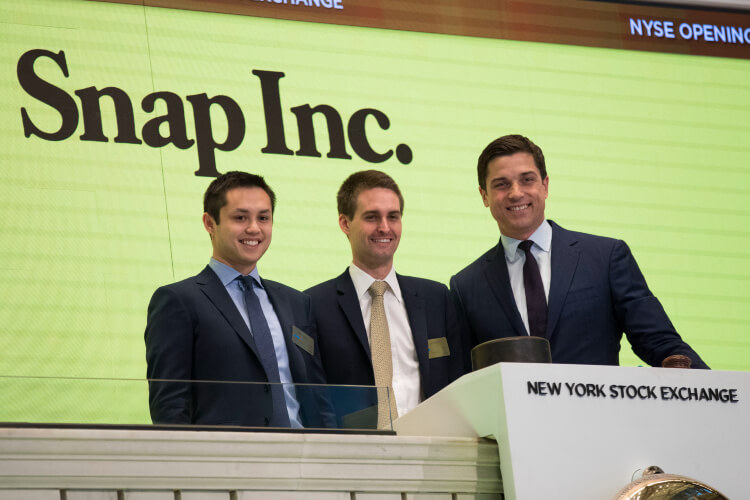
Its stock having been on the decline for the past three months straight, Snap closed out the month of May with a 50% plunge – making it the worst month on record for the company.
The stock took its steepest dive on May 24 after the Snapchat parent company, based in Santa Monica, announced that it was lowering its earnings and revenue expectation for the second quarter. The stock plummeted 43 percent that day.
The stock, which hit a recent high of more than $39 in early April, hovered in the mid-teens last week.
In previous quarters, Snapchat was consistently hitting its goals in terms of revenue and earnings, making the current quarter a shock for investors of the company.
During J.P. Morgan’s 50th Annual Global Technology, Media and Communications Conference, which took place on May 23 in Boston, Snap’s chief executive, Evan Spiegel, said that although the company’s revenue continued to grow year-over-year in the second quarter, the company’s revenue and EBITDA — or earnings before interest, tax, depreciation and amortization — would fall below the projected ranges. He also said the company may slow hiring and look for other ways to cut costs.
“The macroeconomic environment has definitely deteriorated further and faster than we expected when we issued our guidance for the second quarter,” Spiegel said. “Certainly, something that we’re working through along with many other businesses that are impacted, of course, by supply chain issues, inflation, concerns about interest rates, etc.”
Lee Ohanian, a professor of economics at UCLA, said the parent company of Snapchat needs to do “internal searching” over the next few months to understand where its business model needs revamping. He said that advertising is a “highly cyclical” business and that advertising declines a lot relative to when the overall economy weakens.
“What we’re seeing now is a weakened macroeconomy, which means advertisers are going to start pulling back, and advertisers are the primary source of Snapchat’s revenue,” Ohanian said. “So, a weakening economy overall is bad news for the economy, but it is particularly bad for Snapchat.”
Ohanian said Snap will endure a challenging six to nine months, which are going to be especially difficult because of the continuation of the weakening economy. While Snap needs to “ride out the storm,” Ohanian said he expects the company’s leaders to cut out whatever is failing them and implement new ideas. His biggest point: Snap needs to start generating larger profits.
“They’re a $4 billion company with roughly $4 billion in costs. They’re not turning out a profit,” Ohanian said.
Snap is the third largest public company in the Los Angeles area, as ranked in the Business Journal’s “The Lists 2022.” Only The Walt Disney Co. and Amgen Inc. were bigger, as measured by market capitalization.
TikTok Worry
Analysts and investors are also wary about the ever-growing competition Snap faces from other social media companies, especially TikTok.
According to Insider Intelligence, TikTok is projected to triple its ad revenue this year and reach about $5.96 billion. Snap, on the other hand, is projected to make $4.46 billion, a modest increase from 2021’s $4.1 billion figure.
However, as Ohanian pointed out, Snap’s real dilemma is the disruption within the digital ad market sparked by inflation and higher interest rates.
Some analysts have opined that Snap’s young users could be more sensitive to inflation. And most of Snap’s advertisers are packaged goods and fashion brands, the kinds of companies hit hardest by supply-chain issues. It’s reasonable for investors to assume that those companies will cut back on advertising.
Jefferies analyst Brent Thill told CNBC recently that his investors were avoiding tech. “It’s a buyers’ strike. It’s chilly out there…No one wants to touch tech,” he said on “Closing Bell.”
“Everyone is concerned about the fundamentals,” Thill continued. “And most CFOs talk more cautiously about the macroeconomy … everything is starting to slow.”
Snap is not alone. When the company’s stock took a nosedive on May 24, other ad-driven social media companies felt the repercussions as well. Twitter dropped by 3.8%, and Meta fell 6.3%. This downward trend shows how a weakening economy and the uncertainty of global politics are especially depressing for the stock market.
All of these ad-driven platforms have been especially hurt by Apple’s much-discussed privacy policy changes that make it more difficult for advertisers to track potential shoppers by allowing iPhone users to opt-out of sharing their data. Inflation has also made it less likely for people to shop, and rising interest rates sound the alarms for a possible recession.
Goldman Sachs analysts led by Eric Sheridan said in a note that the results and commentary from Snap have been more “volatile” in comparison with larger tech companies like Facebook’s Meta and Google’s Alphabet Inc.
Snap’s second-quarter earnings will be reported on July 28.
